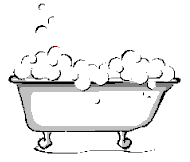 |
|
 |
|
Temperature of water is a very important factor for aquatic life. It controls the rate of metabolic and reproductive activities, and determines which fish species can survive. Temperature also affects the concentration of dissolved oxygen and can influence the activity of bacteria and toxic chemicals in water.

Temperature is measured using a thermometer, and is recorded in either degrees Celsius (° C) or degrees Fahrenheit (° F). While air temperatures reported on television and the newspaper in the U.S. are given in degrees Fahrenheit, scientists usually record temperatures in Celsius, because this is the unit designated by the International System of Units. To convert from ° F to ° C, use this equation:
T° C = [T° F - 32° F] * 5° C / 9° F
For example, the freezing temperature of water is 32° F; this translates to 0° C. The boiling temperature of water is 212° F, or 100° C.

Riparian Vegetation
Riparian vegetation, or trees and plants growing along the banks of a river or creek, provide shade, preventing the sun from heating up the water. If the sun shines directly on water, the water can warm up very quickly, and to very high temperatures.
Flow Rate
During dry seasons, there is less water in a river or creek, and it flows more slowly. This allows the water to warm up more quickly, and to warmer temperatures.
Paved Surfaces

As business and housing developments are built, previously open lands are covered with buildings and pavement. This covered area is called "impermeable surface." Less rain water is soaked into the ground, and more of it runs over land into streams during storms. This runoff also moves faster into the stream than would natural runoff because it travels through straight concrete or plastic storm drain pipes. This increased volume and velocity of runoff scours the stream channel and widens it. During dry weather between storms, the channels have a very shallow flow. These wide, shallow streams heat up much more quickly than do more natural narrow, deep ones.
Additionally, black surfaces, like many streets and parking lots, absorb heat, and rainwater moving over these surfaces during storm events becomes warmer.
Industrial Discharge

Some industries use water as a coolant during processing. This water is sometimes discharged to a stream or lake. When this water is discharged to a creek, it is much warmer than the water in the creek, and the temperature of the creek becomes higher. This phenomenon is called thermal pollution. This can cause the period of ice cover on the water to be shortened, and can increase the metabolic rate of plants and animals, producing an increase in oxygen demand.

Sewage Outflow
Water discharged from treatment plants is warm, because of the wastewater entering the plant (coming from our homes and businesses) is warm. This is another form of thermal pollution.

Water Quality Standards and Other Criteria Regarding Temperature
Colorado Department of Public Health and Environment-Water Quality Control Division (CDPHE-WQCD) regulations (5 CCR 1002-31) state that waters classifed as "Class 1 Cold Water Aquatic Life" should never have temperatures exceeding 20° C, while waters classified as "Class 1 Warm Water Aquatic Life" should never have temperatures exceeding 30° C (http://www.cdphe.state.co.us/cdphereg.asp#wqreg). These regulations also state that temperature for these classes shall maintain a normal pattern of diurnal and seasonal fluctuations with no abrupt changes and shall have no increases in temperature of a magnitude, rate, and duration deemed harmful to the resident aquatic life. Generally, a maximum 3° C increase over a minimum of a 4-hr period, lasting 12 hrs maximum, is deemed acceptable.
Temperature preferences among aquatic species vary widely, but all species tolerate slow, seasonal changes better than rapid changes.
Other Information about Temperature
Respiration of organisms is temperature-related; respiration rates can increase by 10% or more per 1° C temperature rise. Therefore, increased temperature not only reduces oxygen availability, but also increases oxygen demand, which can add to physiological stress of organisms (Giller and Malmqvist, 1998).